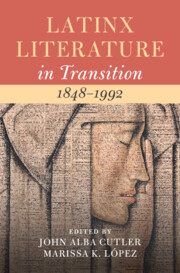Book contents
- Latinx Literature in Transition, 1848–1992
- Latinx literature in transition
- Latinx Literature in Transition, 1848–1992
- Copyright page
- Dedication
- Contents
- Figures
- Contributors
- Acknowledgments
- Introduction
- Part I Space
- Chapter 1 José Garcia Villa’s Sojourn in New Mexico
- Chapter 2 Latinx Internationalism, French Orientalism, and a Nuyorican Morocco
- Chapter 3 Centro America in San Francisco
- Chapter 4 Bridges, Backs, and Barrios
- Part II Being
- Part III Time
- Part IV Form
- Part V Labor
- Bibliography
- Index
- References
Chapter 3 - Centro America in San Francisco
Diasporic Literariness at the End of the Long Nineteenth Century
from Part I - Space
Published online by Cambridge University Press: 10 April 2025
- Latinx Literature in Transition, 1848–1992
- Latinx literature in transition
- Latinx Literature in Transition, 1848–1992
- Copyright page
- Dedication
- Contents
- Figures
- Contributors
- Acknowledgments
- Introduction
- Part I Space
- Chapter 1 José Garcia Villa’s Sojourn in New Mexico
- Chapter 2 Latinx Internationalism, French Orientalism, and a Nuyorican Morocco
- Chapter 3 Centro America in San Francisco
- Chapter 4 Bridges, Backs, and Barrios
- Part II Being
- Part III Time
- Part IV Form
- Part V Labor
- Bibliography
- Index
- References
Summary
This chapter examines a US Central American experience at the end of the long nineteenth century, as reflected in Centro America, a newspaper established by the Comité Unionista Centroamericano de San Francisco in support of the final, formal effort to establish an isthmian nation in 1921. A rare literary text, Centro America provides a cultural account of the complexities and contradictions that shaped the transnational lives of an early Central American diaspora in the US. The weekly paper published unionist essays, the latest local and global news, literary reviews, poems, society columns, and passenger arrival and departure notices that catered to an audience composed of primarily Central American coffee and other elites. However, Centro America also published a letter written by Abel Romero, a Salvadoran, working-class machinist, urging the paper to speak out against El Salvador’s authoritarian government. By allowing different forms of writing to cohabitate, a complex imaginative space emerges in the paper wherein clashing political and class interests create conflict among Central American communities. Print culture, I contend, visibilizes ruptures that emerged in Centro America when elites were confronted by the economic precarity that burdened their countrymen in San Francisco, from whom they asked and largely received unionist support.
Keywords
- Type
- Chapter
- Information
- Latinx Literature in Transition, 1848–1992 , pp. 54 - 72Publisher: Cambridge University PressPrint publication year: 2025

